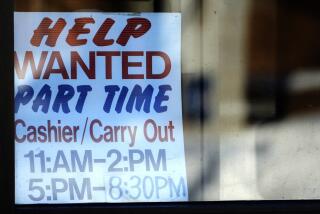White-Collar Wages Decline, Study Reports
- Share via
WASHINGTON — The decline in wages of most blue-collar workers during the early and mid-1980s spread in recent years to women, white-collar workers and college-educated employees, according to a study to be released today by a labor-oriented think tank.
In the study, titled “The State of Working America,” the Economic Policy Institute said that the average wages for workers in those categories fell between 1987 and 1991. After adjusting for inflation, the declines were 2.8% for women, 3.1% for college graduates and 4.4% for all white-collar workers, the institute said.
Those groups had largely escaped the earlier wage reductions experienced by an estimated 75% of blue-collar workers, whose inflation-adjusted income fell about 10% from 1979 to 1987. Most blue-collar workers were males who lack a college degree, the study said.
The larger theme of the report, by institute economists Lawrence Mishel and Jared Bernstein, is that the recession that began in 1990 is attributable to bad policies pursued by the Reagan and Bush Administrations.
“The economy is failing most Americans, and not simply because of the early 1990s recession: We are in the midst of a long-term erosion of incomes and opportunities,” the report said. “The peculiarly white-collar nature of the early 1990s recession has contributed to low consumer confidence and the generalized economic fears that the younger generation will not fare as well as their predecessors.”
Steve Hoffman, spokesman for Labor Secretary Lynn Martin, suggested that the report’s message is strongly influenced by election-year politics. He noted that Democratic nominee Bill Clinton is backed by the AFL-CIO, which provides almost 40% of the Economic Policy Institute’s funding.
While declining to comment specifically on the report because he had not read it, Hoffman said: “It is very popular for people with a political agenda to look back critically at the 1980s without recognizing that 22 million new jobs were created then, with 62% going to women, minorities and immigrants.
“Those millions of people who had the opportunity to participate in the work force feel differently from those who are looking at the numbers now and saying they are dreadful,” Hoffman said.
The report said that white-collar unemployment has increased at a faster rate than blue-collar during the recession, reflecting the end of the boom in finance, retail trade, banking and real estate. In contrast, during the previous five recessions, the authors said, white-collar workers lost jobs at only half the rate of blue-collar workers.
A declining wage gap between men and women is caused primarily by falling income among men, rather than rising wages for women, the report said. Between 1979 and 1991, men’s wages dropped 12.9% after adjusting for inflation, while women’s wages grew 2.4%.
The report also said that the slowed rate of U.S. economic growth in the 1980s did not affect all families equally. The income of the richest 1% of American families grew 63% from 1980 to 1989, while the bottom 60% of American families saw their incomes decline.
More to Read
Get the L.A. Times Politics newsletter
Deeply reported insights into legislation, politics and policy from Sacramento, Washington and beyond. In your inbox twice per week.
You may occasionally receive promotional content from the Los Angeles Times.










